A History of the County of Berkshire: Volume 4. Originally published by Victoria County History, London, 1924.
This free content was digitised by double rekeying. All rights reserved.
'Parishes: Letcombe Bassett', in A History of the County of Berkshire: Volume 4, ed. William Page, P H Ditchfield (London, 1924), British History Online https://prod.british-history.ac.uk/vch/berks/vol4/pp217-222 [accessed 9 May 2025].
'Parishes: Letcombe Bassett', in A History of the County of Berkshire: Volume 4. Edited by William Page, P H Ditchfield (London, 1924), British History Online, accessed May 9, 2025, https://prod.british-history.ac.uk/vch/berks/vol4/pp217-222.
"Parishes: Letcombe Bassett". A History of the County of Berkshire: Volume 4. Ed. William Page, P H Ditchfield (London, 1924), British History Online. Web. 9 May 2025. https://prod.british-history.ac.uk/vch/berks/vol4/pp217-222.
In this section
LETCOMBE BASSETT
Ledecumbe (xi cent.); Up Ledecombe Basset, Ledecoumbe, Upletecomb (xiv cent.); Upledecombebasset (xv cent.).
The parish of Letcombe Bassett lies on the north side of the Berkshire Downs at the head of a deep combe, through which runs the brook or 'lete' from which it takes its name, and it extends also for a considerable distance on the southern slope. It contains 1,631 acres, of which 996 are arable, 368 permanent grass and 16 woods and plantations. (fn. 1) The chief crops are wheat, barley and oats. The highest point in the parish, on the top of the downs just above the village, is 752 ft. above the ordnance datum, while the lowest, beside the brook, has an altitude of 367 ft. Neither high road nor railway runs through the parish, and the nearest station, Wantage Road, on the Great Western main line, is 5 miles distant. The population is principally agricultural.
Two round barrows on the downs to the south of the village were opened in 1880 by Canon Greenwell, and there is a third on Nutwood Down, not far from the parish boundary. (fn. 2) Near them are some signs of primitive terrace cultivation. (fn. 3) The Ridgeway, often confused with the Icknield Way, runs along the top of the downs above the village. (fn. 4)
Dean Swift retired to the rectory here in June 1714, and stayed three months with his friend Mr. Geree, the rector, during which time he wrote 'Free Thoughts on the Present State of Affairs.' (fn. 5)
There is a Methodist chapel in the village.
An Act for inclosing the common fields was passed in 1772, and the award is dated 25 February 1774. (fn. 6) A second Act was passed in 1801, the award being dated 5 October 1804. (fn. 7)
Manor
The manor of LETCOMBE BASSETT had been held by Wigot of Wallingford in the time of King Edward the Confessor, and, like his other lands, passed to Robert Doyley, who was holding it at the time of the Domesday Survey. (fn. 8) The overlordship formed part of the honour of Wallingford. (fn. 9)
This manor, like many others belonging to Robert Doyley, seems to have passed to the Bassets, (fn. 10) Richard Basset being in possession about 1158. (fn. 11) It probably formed part of the six fees held of the honour of Wallingford in 1201 by Richard's son Thurstan, (fn. 12) who died about 1222, (fn. 13) leaving as his heirs six daughters. Of these Isabel married Robert Mauduit, and left a son William, who held the manor in 1231 under a grant from his grandfather. The other five daughters were Joan the wife of Robert de Burnebu, Alice the wife of John le Brun, Egeline the wife of Richard Burdun, Lawrencia the wife of Ralph de Wedon, and Maud the wife of Bartholomew de Rakinton. The first four of these sisters claimed certain shares of the land here, stating that at the time of the alleged grant to their nephew their father Thurstan was suffering from a stroke of paralysis and was unfit to dispose of his property. (fn. 14) Maud's name does not occur in this suit, though she seems to be identical with Maud de Hesserugh who was living in 1236 (fn. 15); probably, therefore, she had already released her right to William Mauduit, who obtained a quitclaim from Joan and Robert de Burnebu in 1233, (fn. 16) and presumably another from Lawrencia de Wedon, as she was not one of the coparceners in 1258, (fn. 17) and the holding of the Peverels, who eventually succeeded to Mauduit's share, was afterwards described as one and a third knight's fee, (fn. 18) four-sixths of the two fees which formed the original Basset estate. (fn. 19) William Mauduit granted his share to his only daughter Isabel on her marriage with William Beauchamp of Elmley in Worcestershire, (fn. 20) and William and Isabel gave it with the exception of the advowson of the church in 1249 for a term of years to Isabel de Mortimer. (fn. 21) In 1252 they granted two parts of the manor to Alice de Scothot for life. (fn. 22)
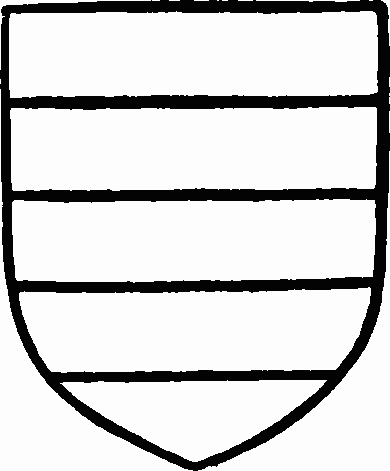
Mauduit. Argent two bars gules.
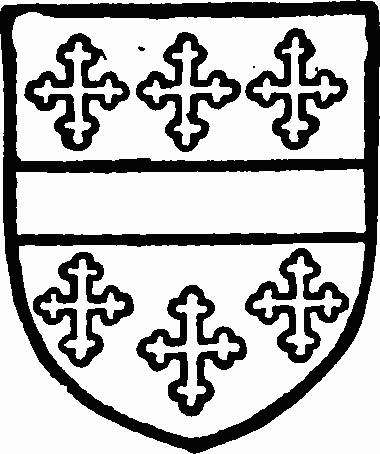
Beauchamp. Gules a fesse between six crosslets or.
As Isabel's death the manor passed to her son William Beauchamp Earl of Warwick, who granted it for life to William Comyn. (fn. 23) The earl died in 1298, leaving as his heir his son Guy. (fn. 24) Guy gave this manor for life to Gilbert Popham, (fn. 25) and granted it early in 1307 to Walter de Langton, Bishop of Coventry and Lichfield, (fn. 26) who obtained a grant of free warren over his demesne lands here on the same day. (fn. 27) The bishop had been treasurer before his consecration, and was the principal adviser of King Edward I during the latter part of that monarch's reign. As soon as Edward II came to the throne Langton was thrown into prison and his lands confiscated. (fn. 28) It was not until January 1312 that he was released and John de Beche, who had had custody of this manor, was ordered to restore it. (fn. 29) Langton, who was in that year reappointed treasurer, (fn. 30) was holding it in 1316, (fn. 31) but seems to have granted it shortly afterwards to Giles de Wattisham (fn. 32) for life; he died in November 1321, when his heir was his nephew Edmund, son of Robert Peverel, then fifteen years of age. (fn. 33)
Edmund Peverel lived at Castle Ashby in Northamptonshire, and died in 1331, leaving as his heir his son John, (fn. 34) who died in 1349. (fn. 35) John's widow Isabel, with her second husband Robert de Bradeston, claimed a third of this manor as her dower in 1350 from Margaret the sister and heir of John, who had married Sir William dela Pole. (fn. 36)
William de la Pole died in 1366 (fn. 37) and the manor passed to his son Sir John de la Pole, who had married in 1362 Joan daughter and heiress of John Lord Cobham. (fn. 38) Joan died about 1388, and her daughter Joan inherited this manor as well as the barony of Cobham. (fn. 39) Joan's first husband, Sir Robert Hemenhall, died in 1391, and she married Sir Reynold Braybrook, who joined her in a settlement of the manor in 1403. (fn. 40) By him she had an only child Joan, who afterwards married Sir Thomas Brooke. (fn. 41) In 1428 Sir Thomas and Joan gave their consent to a settlement of the manor on Sir John Harpeden, the last husband of the elder Joan, for life. (fn. 42)
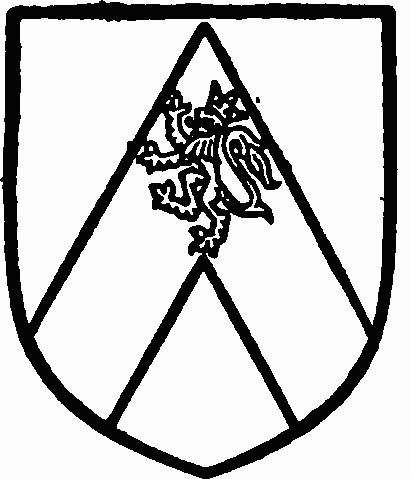
Brooke. Gules a cheveron argent with a lion sable thereon having a golden crown.
Sir Thomas Brooke died in 1439, when he was succeeded by his son Edward Lord Cobham, who died in 1464, leaving as his heir his son John. (fn. 43) John Lord Cobham died 9 March 1512 and his son and heir Thomas mortgaged this manor 22 May 1520 to Robert Dormer, (fn. 44) who sold it 30 April 1524 to William Fettiplace. (fn. 45) William Fettiplace died about 1529, leaving this manor and other lands by his will to John Pantre, the Provost, and the scholars of Queen's Hall, Oxford, on condition that they paid certain rents from it to the chantry and almshouses which he had founded at Childrey. (fn. 46)
Thomas Brooke Lord Cobham, who had sold the manor, died 19 July 1529, (fn. 47) and his son George Lord Cobham unsuccessfully laid claim to it in 1530, (fn. 48) but in 1532 he released all his interest to the college for £20. (fn. 49) The Provost and Fellows of Queen's College, Oxford, are the present holders of the manor.
The other co-heirs of Thurstan Basset who were parties to an agreement concerning the advowson of Letcombe in 1258 were Richard Longespée and William le Brun. (fn. 50) This William, who seems to have been the son of John and Alice le Brun, released his right to land here in 1247 to William Asselin, (fn. 51) and in 1301 another William Asselin, steward of Peter de Leicester, baron of the Exchequer, (fn. 52) obtained from Guy Beauchamp a quitclaim of his right in certain lands here, which he granted in the following year to the priory of Bicester. (fn. 53) He further obtained licence in 1332 to grant to the priory a sixth part of the manor of 'Upletcombe' with certain lands there which were held of Giles de Wattisham, then the holder of Langton's share, and William le Brun of Norton. (fn. 54) The Prior of Bicester leased his demesne lands here to tenants at a rent which gradually decreased from £6 13s. 4d. in 1396 to £4 in 1452. (fn. 55) The latter sum was still paid at the time of the Dissolution (fn. 56) and in May 1557, when 'Mystrys Russell' was the intending purchaser of the manor, (fn. 57) which was, however, sold later in the same year to Thomas Gratwick and Anselm Lamb. (fn. 58) Anthony More and his wife Alice and Henry Smith and his wife Elizabeth, who dealt with a manor of Letcombe Bassett in right of Alice and Elizabeth in 1553 (fn. 59) may have been tenants of this estate, which had passed by 1586 to Richard More; he sold it in that year to Adam Blandy, (fn. 60) whose family long held the farm still known as Blandy's.
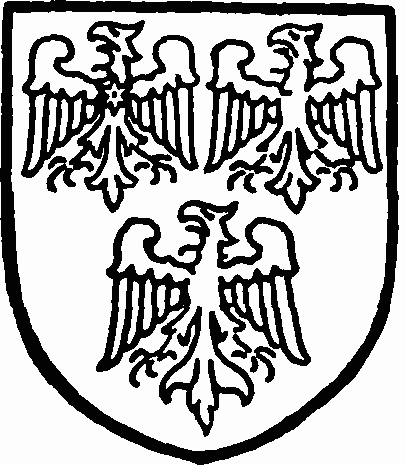
Queen's College, Oxford. Argent three eagles gules with a molet or on the breast of the first eagle.
Richard Longespé, mentioned in 1258 as a coparcener of the advowson, (fn. 61) was the son of Egeline wife of Richard Burdun, (fn. 62) who granted him all her lands in Letcombe Bassett after her husband's death. (fn. 63) Richard was succeeded by Sir Nicholas Burdun, (fn. 64) who died in 1273, leaving as his heir his son Robert. (fn. 65) Robert died about 1280, (fn. 66) leaving a son Nicholas, a minor, (fn. 67) whose wardship was granted to Queen Eleanor. (fn. 68) She was holding part of the advowson on this account in 1283, (fn. 69) but the estate may have passed before this time, as the advowson did later, to Henry de Anwick, for a messuage and land with a third of a mill at Letcombe and Kingston were settled in 1278–9 on Henry de Anwick, who was to hold the property of Richard Benham and his wife Constance. (fn. 70) The estate passed before 1316 to John de Anwick, who was holding the third part of a knight's fee in Letcombe Bassett in that year (fn. 71) and in 1332. (fn. 72) In 1428 it belonged to Alice wife of Philip Brenham or Benham, (fn. 73) who granted it in 1452 to Simon Brenham and his heirs, (fn. 74) but no further reference to it has been found.
Sir Edmund de Childrey died on 14 April 1372 seised of 4 virgates of land here held of the heir of William de la Pole, (fn. 75) and this holding was increased by Sir Thomas de Childrey to 6 virgates of land (fn. 76); it passed with the manor of Frethornes in the parish of Childrey (q.v.) until 1703, when it was in the possession of Robert Knight. (fn. 77) Part of this estate followed the descent of the manor of Mautravers in the parish of Childrey (q.v.) from 1577 to 1634. (fn. 78) Another portion seems to have been alienated much earlier, perhaps by the Childreys, for in 1625 Nicholas Aldworth of Frilford died seised of a 'manor' of Letcombe Bassett which he had purchased in 1624 from Robert and Richard Shepreve. It was said to be held of Frethornes. (fn. 79) His heir was his son Richard, who bought Anwicks Manor in Letcombe Regis in 1627–8, and the estate at Letcombe Bassett descended with Anwicks (q.v.) until 1716, (fn. 80) when it is mentioned for the last time.
The priory of Poughley in the parish of Chaddleworth held certain lands here of the gift of William Quartremains, confirmed to them by Thurstan Basset. (fn. 81) After the Dissolution these lands were granted in 1526 to Wolsey for his new college at Oxford, (fn. 82) and after the cardinal's attainder were given in 1531 to the Abbot and convent of Westminster. (fn. 83) They were transferred in 1559–60 to the dean and chapter, (fn. 84) who attached them to their manor of Letcombe Regis.
There were two mills here, worth £3 at the time of the Domesday Survey, (fn. 85) both of which are mentioned about the middle of the 12th century. (fn. 86) Two thirds of a mill were granted by William and Isabel Beauchamp to Henry de Halescombe and one third was settled in 1278–9 on Henry de Anwick. (fn. 87) Both mills seem to have been still in existence in 1402, when they were appurtenances of the manor that had belonged to William Mauduit. (fn. 88) There is now only one mill in the parish; it stands on Letcombe Brook, rather more than a quarter of a mile north of the village.
Church
The church of ST. MICHAEL (fn. 89) consists of chancel 25 ft. by 11 ft. 6 in., with south vestry, nave 39 ft. 6 in. by 17 ft. 6 in., south aisle 29 ft. 6 in. by 7 ft., north porch, and west tower 8 ft. by 7 ft., all these measurements being internal.
The chancel is of 12th-century dale and probably also the walls of the nave, but all the nave windows are of a later period, and the masonry being stuccoed makes it difficult to determine whether the original walls were rebuilt or whether the windows are insertions. The chancel may have been lengthened c. 1280–90, to which period its east and south windows belong, but its plan and the absence of all buttresses rather suggest that the whole is 12th-century work with later windows inserted. Towards the end of the 13th century the building underwent great changes, the north doorway and the tower being both of that period. The westernmost window on the south side of the chancel may be rather earlier, and that on the south side of the nave east of the aisle is of the late 14th century. The remaining old window, on the north side of the nave, is a 15thcentury insertion, the other two being modern. That near the pulpit dates from 1909. The south aisle was added in 1862, when the church underwent a restoration, and the porch and vestry are also modern. The west side of the tower has been rebuilt in brick, perhaps in the first half of the 18th century, and the whole of the tower was repaired in 1884.
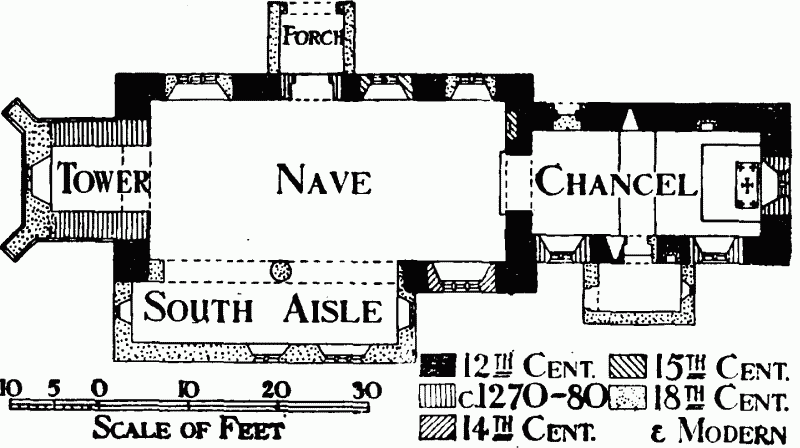
Plan of Letcombe Bassett Church
With the exception of the brickwork in the tower and the south and east sides of its upper stages, which are of coursed rubble masonry with large quoins, the whole of the walling of the church is stuccoed externally and plastered inside. The roof of the nave is covered with lead overhanging at the eaves, and those of the chancel and aisle are tiled.
The chancel has a pointed east window of two plain lights with a quatrefoil within a circle in the head. On the north side is a small 12th-century round-headed window high up in the wall with square external rebate and head in one stone without label, and there is a similar window opposite on the south side now opening to the vestry. Further west on the north side is an original round-headed doorway, now built up, with tympanum and arch of a single order with roll moulding on the edge, springing from quirked and chamfered imposts and angle shafts with cushion capitals and moulded bases. On the flat surface of the capitals are carved the emblems of the four Evangelists, the angel and the eagle on the east and the lion and the ox on the west of the opening, the width of which is only 23 in. The square inner jambs support a lintel with chamfered edge below the tympanum, the surface of which is scored across with horizontal, perpendicular and diagonal lines and may originally have had a thin coat of plaster. The neckings of the shafts below the capitals have on the east side an interlaced and on the west a cable moulding, and the figures above are boldly carved. The doorway was described in 1849 as 'blocked up for a fireplace,' (fn. 90) but the wall inside now shows no signs of this or of the original opening. In the south wall of the chancel are two windows, one near each end, that to the west being the older and consisting of two plain coupled lancets without containing arch or hood mould, and the other of two trefoiled lights with circle above, below a pointed arch and label. The modern doorway to the vestry cuts into the sloping sill of the 12th-century window, and the roof consists of coupled spars with a single tie-beam. There are no remains of ancient ritual arrangements. The semicircular chancel arch is of a single square order springing from chamfered and carved imposts. The arch and jambs are quite plain, but it is possible that the opening may have been altered at some time in the 18th century, when probably the indented plaster ornament round the arch was added and the whole of the wall surface plastered. (fn. 91) The imposts, however, are remarkable for the rich nature of the ornament with which they are covered and are returned some little distance along the west wall, north and south, though not taken through the full thickness of the wall. On the south side is a beautiful scroll pattern with a band of cable moulding below, while on the north is a scroll facing west and on the inner face an antique or leaf pattern, both with cable below. On either side of the arch at the east end of the nave is a niche, probably of 15th-century date, that on the north side having a trefoiled head, above which is the upper doorway to the rood-loft, all other trace of which is gone. A thickening in the wall outside at the junction of the chancel and nave indicates the position of the rood-stairs, but the lower doorway has disappeared.
The 15th-century window in the nave is squareheaded and of two cinquefoiled lights; that to the west of the porch is modern. The pointed north doorway has continuous moulded head and jambs, but no label. Near to the eastern jamb inside is a pointed stoup. The south side of the nave is open for the greater part of its length by a modern arcade of two pointed arches to the aisle, but is lighted at its east end by a square-headed window of three trefoiled ogee lights with inverted trefoils in the head, probably dating from c. 1380–90. The roof of the nave is apparently of 15th-century date, when it replaced an older one of higher pitch. It consists of four bays with moulded tie-beams and chamfered intermediate rafters and purlins. The principals are carried down the walls and rest on stone corbels carved with a saltire within a square frame. The ridge of the roof is below that of the chancel.
The tower is of three stages with diagonal buttresses on the west side and terminates in a straight parapet. The two lower stages are unmarked externally, the walls being unbroken up to the string below the belfry. The west side is faced its entire height with 2½-in. bricks and the buttresses and dressings are of red sandstone contemporary with the brickwork. The west window is of two trefoiled lights without containing arch or hood mould and may be a late 13th-century window reset or a late copy of an old opening. The belfry windows are plain square-headed openings, one on each side, and the parapet is moulded. The tower arch is of three chamfered orders without hood mould, towards the nave, and two facing west, dying into the wall at the springing. There is no vice.
The font consists of a plain circular stone bowl and stem on an octagonal to square base, and may be of 13th-century date. The pulpit and fittings are all modern. There are no ancient monuments, but in the chancel floor are inscribed stones to two former rectors, the Rev. W. Durham (d. 1686) and the Rev. H. Hill (d. 1707).
There is a ring of three bells, two dated 1576 and inscribed, 'Hail Mari ful of Gras. W.R.' and 'Glori to God on hi in earth pes,' and the third cast by Oliver Cor of Aldbourne in 1726.
The plate is all modern and consists of a chalice, paten and flagon of 1862 by Keith; there is also a plated paten.
The registers before 1812 are as follows: the first volume is in two parts, the first containing entries from 1564 to 1642 and some at the end on inserted leaves for the years 1639, 1656, 1662, 1663, 1664, 1674, 1679 and 1681 (fn. 92); the second part contains baptisms and burials from 1683 to 1776 and marriages from 1685 to 1738 (fn. 93); (ii) baptisms and burials from 1776 to 1812, marriages from 1755 to 1767 (fn. 94); (iii) marriages from 1770 to 1812.
The churchyard is surrounded by lime trees and lies chiefly on the north side, where are four good tombs of late 17th and 18th-century date, two of which (one dated 1690) have rounded tops. Of the others, one is dated 1732, and the other is 18thcentury work with 'Gothic' panelling on the sides.
Advowson
Part of the advowson of Letcombe Bassett was given by William Mauduit to his daughter Isabel on her marriage. (fn. 95) In 1258 Alice de Scothot, who had acquired two parts of the manor in 1252, (fn. 96) sued Giles Bishop of Salisbury for not admitting a parson presented by her to the church here. (fn. 97) In 1258 Richard Longespée and William le Brun agreed with William and Isabel Beauchamp and Alice de Scothot that William, Isabel and Alice should present for one turn, then Richard and William for one turn, and afterwards William, Isabel and Alice, and the heirs of Isabel should present twice in succession and the other co-heirs once, and so on for ever. (fn. 98) In 1297 William Asselin and Henry de Anwick gave their shares of the advowson to William Beauchamp Earl of Warwick, (fn. 99) who thus became possessed of the whole. In 1313 John de Anwick unsuccessfully claimed the advowson against Walter de Langton, (fn. 100) and it followed the descent of the Beauchamps'lands here until 1356, when William de la Pole and Margaret his wife sold it to Thomas Palet and others. (fn. 101) From them it seems to have passed to Sir Thomas de Childrey, who died seised of it in 1407. It then passed with the advowson of Childrey to Corpus Christi College, (fn. 102) with the exception of one-third sold in 1561 by George Cope to James Yate and John Smith. (fn. 103) This portion then followed the descent of the manor of Mautravers in Childrey until 1634, (fn. 104) when it was the property of John Ashcombe. It afterwards passed to Corpus Christi College, Oxford, the owners of the larger portion, who presented in 1636, (fn. 105) and are the present patrons.
In 1291 the church was valued at £6 13s. 4d. (fn. 106) and in 1340 the ninths were valued at 10 marks. (fn. 107)
Charities
The fuel allotment, acquired under the inclosure award of 1774, consists of 8 acres let at £3 a year.
In 1884 Percy Smith, by his will proved at Oxford 8 January, bequeathed £500, the income to be distributed among the poor. The legacy is represented by £500 15s. 1d. consols, producing £12 10s. 4d. yearly.
In 1885 Harriet Firth, by her will proved at Oxford 23 June, bequeathed £250 for the same purpose, represented by £248 16s. consols, producing £6 4s. 4d. yearly.
These charities are administered together by the churchwardens, the income being applied in the distribution of coal among all the cottagers, in quantities of from 10 to 12 cwt. to each recipient. The sums of stock are held by the official trustees.
Under the award above mentioned an allotment of 1 a. 2 r. was made for the repair of the roads, &c. The allotment is now the property of the Wantage Urban District Council and let at £1 a year, which is applied in aid of the district rate.
Parish Lands.—By the inclosure award of 1804 an allotment of 2 r. 4 p. was made to the churchwardens and overseers, and by the same award 1 r. 3 p. were allotted to the hayward. These allotments are situated in the township of Challow and are let at £2 a year, which is retained by the churchwardens for their own use.